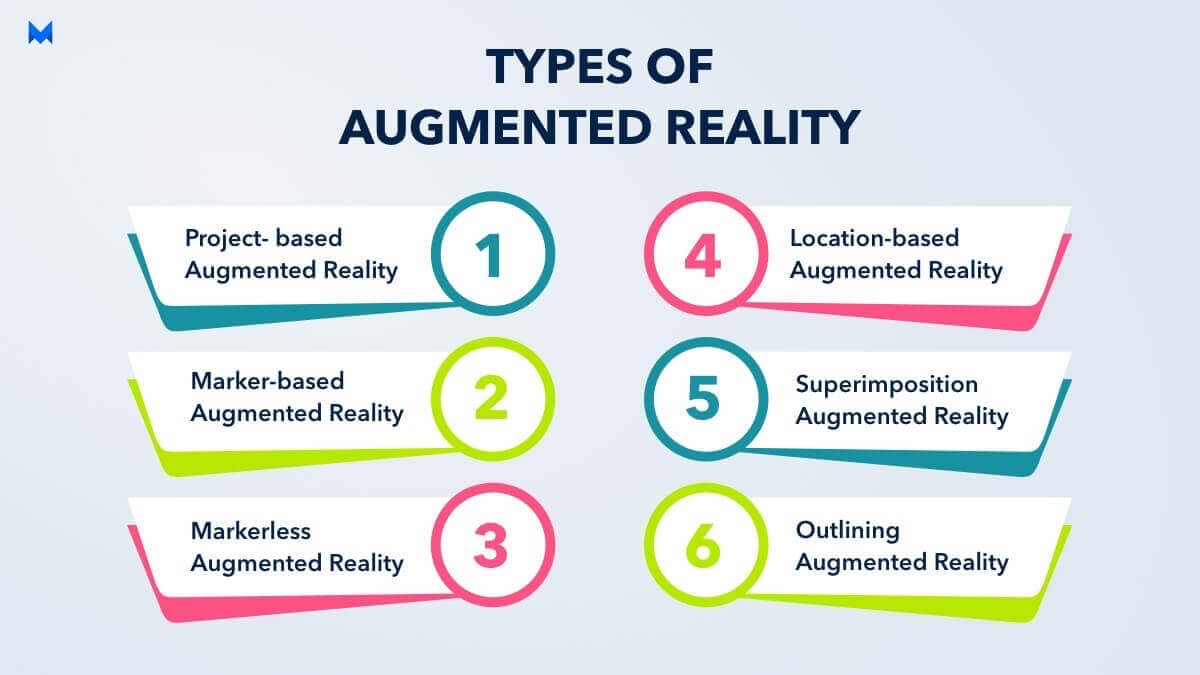Leverage different types of Augmented Reality for your business and deliver a rich user experience, drive maximum user engagement, & increase conversions.
We all know ‘Picture speaks louder than words’ and yes it is so true!
In today’s time, pictures are an interactive way to provide a better and full understanding of a subject with the help of the cognitive technology Augmented Reality (ar).
Undoubtedly, it is a very known technology that is gaining popularity among businesses to represent products, services, methodologies, processes, etc. by ensuring a visually rich user journey. Do you know? Most businesses leverage AR apps to drive immense user engagement to represent their subject effectively and in an appealing manner.
AR has created its own digital space in the digital world by allowing several business domains to maximize business opportunities and gain a competitive advantage. The market is continuously evolving its fundamentals in order to fetch maximum advantages of various types of augmented reality.
Before exploring various kinds of augmented reality, let’s first start with its definition and understand it from the scratch.
Augmented Reality: Definition
What is Augmented Reality?
In simple words, Augmented Reality is the advanced technology of the real physical world that superimposes digital or computer-generated content with the use of visual elements to provide a composite view.
This content could be immersive or interactive in the form of 3D view, text, graphics, and other visual integrated enhancements that consist of multiple sensory modalities.
One of the most gaming-changing technologies for retail in 2021 is an augmented reality which helps retailers to establish a new way to compete with a new user experience leading to increased user satisfaction.
Organizations are leveraging augmented reality uses to enhance their training methods, internal processes, and customer service in the real world.
Well, it’s only just the beginning!
Global market insights state that the AR market will hit 50$ billion by 2024 adopted by various domains like retail, automotive, medical, and others to pump up the operational efficiency.
More for you: Learn how brands are using Augmented Reality in the real world in the ecommerce and retail industry.
Features of Augmented Reality:
There are several features of augmented reality that are worth mentioning regardless of the project you’re working on. These features are as follows:
- 3D Object Tracking
- Smart Glasses Support
- Slam Support
- Geolocation
- Cloud-Storage
Different Types of Augmented Reality:
Many augmented reality app development companies are constantly promoting user experiences by embracing rich and innovative ways of representing digital content. And, this is made possible with the help of using different types of augmented reality.

There are 6 kinds of augmented reality in use today. From retail to gaming, there are a lot of business domains in the exploration phase of embarking on this emerging technology. But the question is… how? Easier asked than answered, for a better understanding of AR usage, let’s walk through the different types of augmented reality.
1. Marker-based AR
The marker-based augmented reality identifies the Physical images, ‘Markers’, and 3D Models with the help of AR applications. When the Augmented Reality app is opened, the app uses a back camera of your mobile device to track such markers.
This type of augmented reality technology is also known as Recognition based AR or Image Recognition. On the basis of marker tracking, AR showcases superimposed content in the form of video, image, 3D models, animation clips, or scenes. With the help of an app, users can interact with this content.
This is one of the popular types of augmented reality that helps users to view the object/image in a more detailed manner and from different angles. In addition to that, when the users rotate the marker, the 3D imaginary rotates simultaneously.
2. Markerless AR
Markerless augmented reality functions without any marker and scans the surrounding environment. This technology allows users who want to insert the virtual object or content, without moving anything in the background.
The markerless AR is one of the major types of virtual reality that is based on the device’s location, digital compass, camera, and accelerometer to collect the positional information. Mobile apps containing such features usually ask the user for a flat surface or floor for placing the AR objects to not make them always float in the air.
The AR app tracks that flat surface and runs the superimposed content over it.
3. Location-based AR
This is one of the most implemented types of augmented reality that is used by users. It primarily depends on GPS, Digital Compass, smartphone cameras, and other technologies to identify the location. Compared to Marker-based AR, it doesn’t require special markers to identify the place where the virtual object is placed.
The digital content is mapped to a specific location. So when the user enters a predetermined location, the objects are displayed on the screen.
Location-based AR doesn’t need any cue from the object to deploy as it can predict from the user’s focus to pair the real-time data with the current location. It also allows developers to showcase creative, interactive, and useful digital content to geographical points of interest in the app. It also adds benefits to travelers to know the whereabouts of any particular area using virtual 3D objects, videos, texts, links, and audio.
4. Superimposition AR
Superimposition AR creates an alternate view of an object and can be used for partial or full replacement of the original view of the object. This means that this technology replaces either the entire view of an object or a portion of it with an augmented view.
In this type of augmented reality, object recognition is highly crucial. In case the app is unable to identify what it is looking at, it will fail to replace the original view with the virtual one. Superimposition AR provides multiple views of a target object with a choice of highlighting the extra relevant information on that object.
5. Projection-based AR
This type of technology is not operated by the user. Projection-based AR is a video projection technique that can extend or deliver digital data by projecting images on the surface of 3D objects or the user’s physical space.
This is one of the most beneficial types of augmented reality that allows users to freely move around the environment within a specified space where the projector and camera are placed. With this technology, it is easy to execute graphical representations with high-definition images or videos that usual lighting techniques cannot show. It can also change the visual shape of the object with the flow of time.
This is an augmented reality software that creates illusions on the basis of depth, position, and orientation of an object by throwing artificial light onto the real flat surfaces under proper guidance to simplify the complex manual tasks in businesses. The best part is it wipes out the need for computers and screens as the instructions are placed on a particular task space.
6. Outlining AR
This is another type of augmented reality that identifies the lines and boundaries with an updated augmented view of an object that human eyes cannot recognize. It uses special cameras to perform such actions in certain situations. This technology uses object recognition for a broader understanding of the present environment.
Outlining AR is exclusively used in-car navigation systems for safe driving after sunset times.
Final Note:
It is quite easy to access. Isn’t it?
The best part of AR is, it can be easily accessible by any ordinary user who can view and interact with digital content even if they lack a technical background. Users only have to install AR apps on their smartphones.
All they need to do is scan any image or object on a table-like surface through the phone to view the computer-generated content or visuals. This app could be your own or any AR app that can be picked out from App Store or Play Store.
If you are a business that is looking to impose simple videos or animations on your products, you have the choice to ask your customers to use such AR apps.
However, to deliver highly interactive and seamless experiences, creating your own AR app is the best choice that can leverage hi-tech projects using projectors or special cameras.
There are big IT companies that are putting extra effort into developing Augmented Reality tools for startups or enterprises by developing customized augmented reality apps to achieve the desired business goals.
If you are looking for augmented reality app development, all it demands is a specialized app development company with a certain set of skills apart from hands-on expertise.
Mobcoder, an AR development company, has the ability to pull it off for you & assist you in developing AR solutions of any size or complexity including virtual reality content. Get started today!











